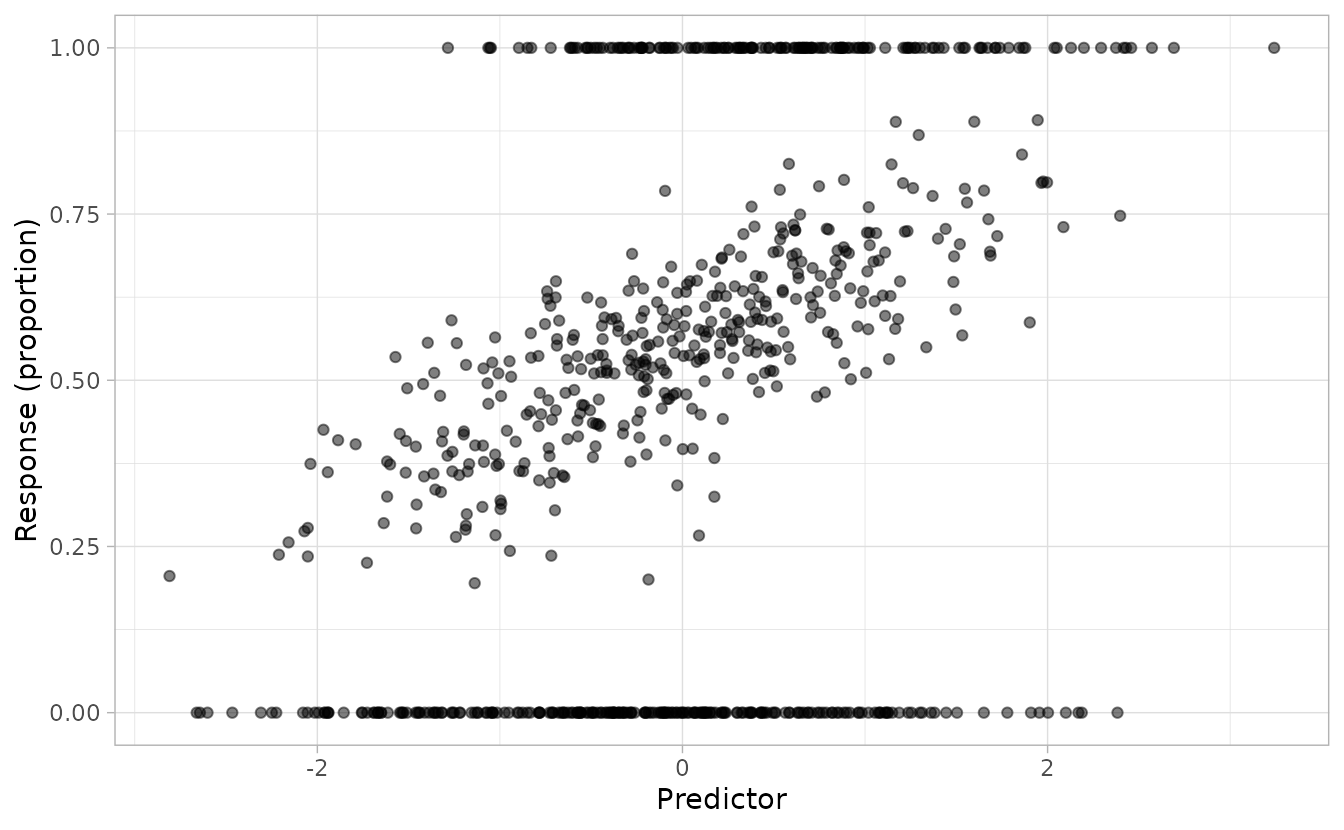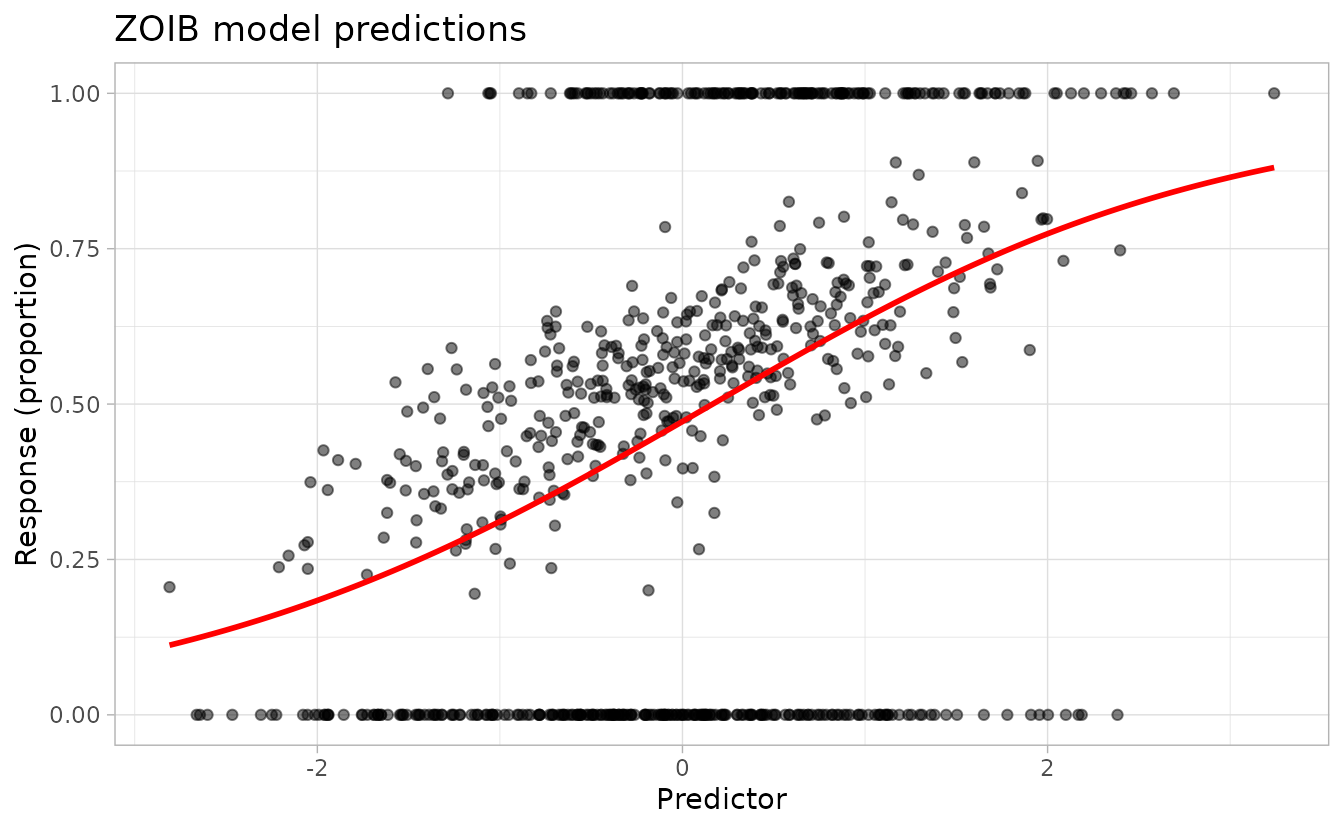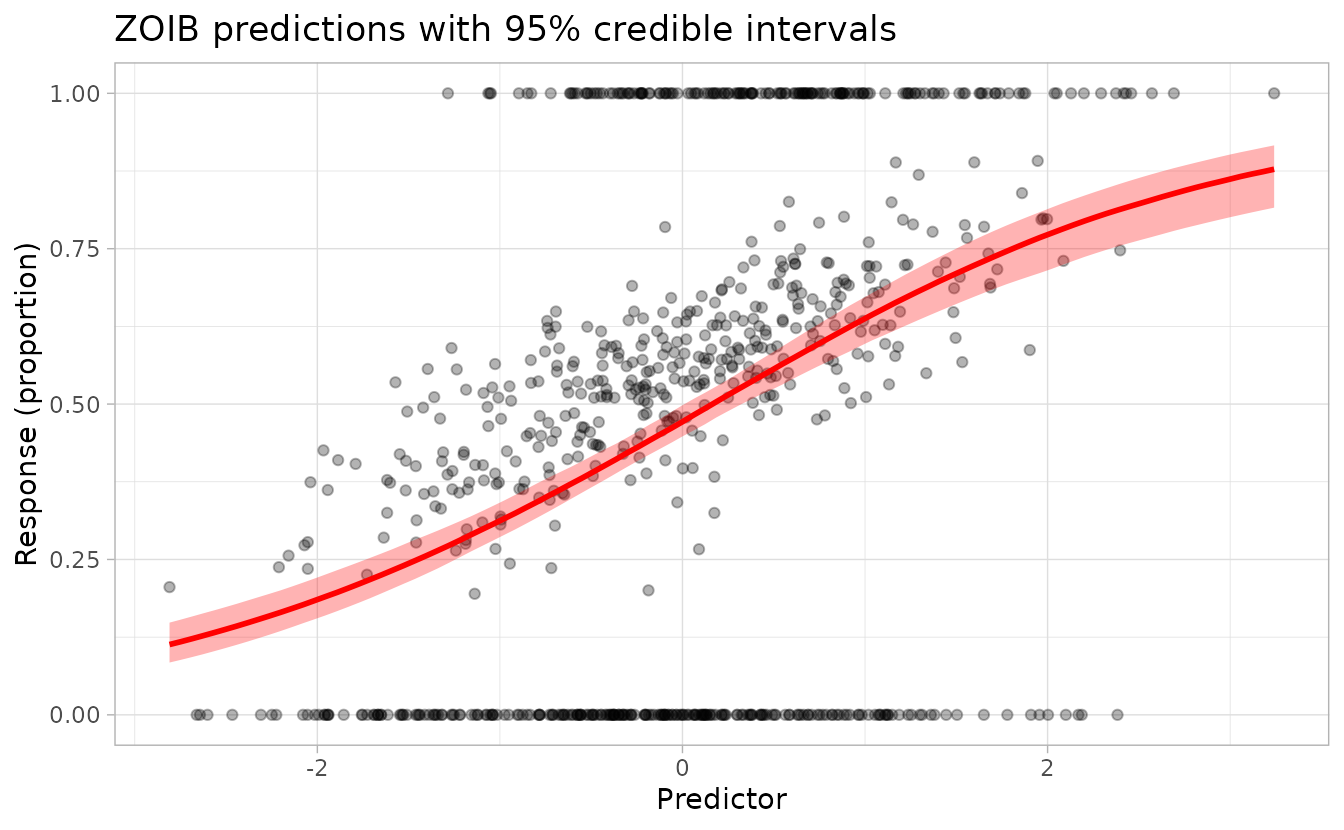
Zero-one-inflated beta (ZOIB) models with sdmTMB
Sean Anderson
2025-11-11
Source:vignettes/articles/zoib.Rmd
zoib.RmdIf the code in this vignette has not been evaluated, a rendered version is available on the documentation site under ‘Articles’.
Introduction
Zero-one-inflated beta (ZOIB) models are used for modeling proportional data (values bounded between 0 and 1) that include excess zeros and/or ones beyond what would be expected from a standard beta distribution. These models are useful for analyzing data such as:
- Species abundance as a proportion of maximum capacity
- Habitat suitability indices
- Proportional cover data in ecology
- Any other response variable that is a true proportion with potential inflation at the boundaries
A ZOIB model consists of three components:
- A zero component: models the probability of a zero value (typically using a binomial/logit model)
- A one component: models the probability of a one value (typically using a binomial/logit model)
- A proportion component: models the continuous proportion between 0 and 1 (typically using a beta distribution)
The final prediction combines all three components:
where is the probability of zero, is the probability of one (given not zero), and is the expected proportion from the beta component.
Currently, sdmTMB does not have a built-in ZOIB family. However, ZOIB models can be implemented by fitting three separate models and combining their predictions. This vignette demonstrates this approach.
Simulating ZOIB data
Let’s simulate data from a ZOIB process to illustrate how to fit these models in sdmTMB.
First, we’ll set up the parameters for our simulation:
set.seed(123)
N <- 800
x <- rnorm(N)
# Coefficients for the zero component (logit scale)
b_0 <- c(-1, -0.4)
# Coefficients for the one component (logit scale)
b_1 <- c(-1, 0.6)
# Coefficients for the proportion component (logit scale for mean)
b_prop <- c(0.2, 0.5)
# Precision parameter for beta distribution
phi <- 30Now we’ll simulate the three components:
# Zero component: probability of observing a zero
p <- plogis(cbind(rep(1, N), x) %*% b_0)
y_p <- rbinom(N, 1, p)
# One component: probability of observing a one (given not zero)
q <- plogis(cbind(rep(1, N), x) %*% b_1)
y_q <- rbinom(N, 1, q)
# Proportion component: beta-distributed values between 0 and 1
mu <- plogis(cbind(rep(1, N), x) %*% b_prop)
a <- phi * mu
b <- phi * (1 - mu)
y_r <- rbeta(N, a, b)Finally, we combine the components to create the ZOIB response:
y <- numeric(length = N)
y[y_p == 1] <- 0
y[y_p != 1 & y_q == 1] <- 1
y[y_p != 1 & y_q != 1] <- y_r[y_p != 1 & y_q != 1]
dat <- data.frame(x, y)
ggplot(dat, aes(x, y)) +
geom_point(alpha = 0.5) +
labs(x = "Predictor", y = "Response (proportion)")
The plot shows the characteristic ZOIB pattern: data concentrated at 0 and 1, with continuous values between.
Fitting the ZOIB model components
To fit a ZOIB model with sdmTMB, we fit three separate models and combine their predictions.
First, we prepare the data for each component:
# Zero component: 1 if zero, 0 otherwise
dat$y_zero <- ifelse(dat$y == 0, 1, 0)
# One component: 1 if one, 0 if between 0 and 1, NA if zero
dat$y_one <- ifelse(dat$y == 1, 1, ifelse(dat$y < 1 & dat$y != 0, 0, NA))
# Proportion component: the value itself, but only for values between 0 and 1
dat$y_proportion <- ifelse(dat$y < 1 & dat$y > 0, dat$y, NA)Now we fit the three models. In this example, we turn off spatial
effects with spatial = "off", but in practice you could
include spatial and spatiotemporal random fields in any or all of the
components:
# Model 1: Zero component
fit_zero <- sdmTMB(
y_zero ~ x,
data = dat,
family = binomial(link = "logit"),
spatial = "off"
)
# Model 2: One component (excluding zeros)
fit_one <- sdmTMB(
y_one ~ x,
data = subset(dat, !is.na(y_one)),
family = binomial(link = "logit"),
spatial = "off"
)
# Model 3: Proportion component (values between 0 and 1)
fit_proportion <- sdmTMB(
y_proportion ~ x,
data = subset(dat, !is.na(y_proportion)),
family = Beta(link = "logit"),
spatial = "off"
)Let’s check how well we recovered the simulation parameters:
# Zero component coefficients
coef(fit_zero)
#> (Intercept) x
#> -0.8702097 -0.4254690
b_0
#> [1] -1.0 -0.4
# One component coefficients
coef(fit_one)
#> (Intercept) x
#> -1.0390158 0.7738772
b_1
#> [1] -1.0 0.6
# Proportion component coefficients
coef(fit_proportion)
#> (Intercept) x
#> 0.2114247 0.4901013
b_prop
#> [1] 0.2 0.5
# Precision parameter
tidy(fit_proportion, "ran_pars")
#> # A tibble: 1 × 5
#> term estimate std.error conf.low conf.high
#> <chr> <dbl> <dbl> <dbl> <dbl>
#> 1 phi 29.6 2.09 25.8 34.0
phi
#> [1] 30The estimated coefficients should be close to the true values used in the simulation.
Making predictions
To make predictions from a ZOIB model, we need to:
- Generate predictions from each component
- Combine them using the ZOIB formula
First, create a new data frame for prediction:
nd <- data.frame(x = seq(min(x), max(x), length.out = 100))Point predictions
Generate point predictions from each component and combine:
# Get predictions on the response scale (probabilities/proportions)
p0 <- plogis(predict(fit_zero, newdata = nd)$est)
p1 <- plogis(predict(fit_one, newdata = nd)$est)
pp <- plogis(predict(fit_proportion, newdata = nd)$est)
# Combine using ZOIB formula: E[Y] = (1 - p0) * (p1 + (1 - p1) * pp)
nd$est <- (1 - p0) * (p1 + (1 - p1) * pp)Plot the predictions:
ggplot(dat, aes(x, y)) +
geom_point(alpha = 0.5) +
geom_line(aes(x, est), data = nd, colour = "red", linewidth = 1) +
labs(
x = "Predictor", y = "Response (proportion)",
title = "ZOIB model predictions"
)
Predictions with uncertainty
To incorporate parameter uncertainty, we use can use simulation-based
inference. The predict() function with nsim
will draw from the joint precision matrix of the fixed effects and
random effects:
# Generate simulation draws from each model
p0 <- plogis(predict(fit_zero, newdata = nd, nsim = 500))
p1 <- plogis(predict(fit_one, newdata = nd, nsim = 500))
pp <- plogis(predict(fit_proportion, newdata = nd, nsim = 500))
# Combine the simulations
combined <- (1 - p0) * (p1 + (1 - p1) * pp)
# Calculate median and credible intervals
nd$est2 <- apply(combined, 1, median)
nd$lwr <- apply(combined, 1, quantile, probs = 0.025)
nd$upr <- apply(combined, 1, quantile, probs = 0.975)Plot with uncertainty bands:
ggplot() +
geom_point(data = dat, aes(x = x, y = y), alpha = 0.3) +
geom_ribbon(
data = nd, aes(x = x, ymin = lwr, ymax = upr),
fill = "red", alpha = 0.3
) +
geom_line(
data = nd, aes(x = x, y = est2),
colour = "red", linewidth = 1
) +
labs(
x = "Predictor", y = "Response (proportion)",
title = "ZOIB predictions with 95% credible intervals"
)
The red line shows the median prediction and the shaded region shows the 95% credible interval accounting for parameter uncertainty.
Comparison with the zoib package
For reference, we can compare our approach to the dedicated ZOIB
implementation in the zoib package, which uses Bayesian
methods:
library(zoib)
m <- zoib(y ~ x | 1 | x | x,
data = dat,
zero.inflation = TRUE,
one.inflation = TRUE,
joint = FALSE,
n.iter = 600,
n.thin = 1,
n.burn = 100
)
# Extract parameter estimates
sample1 <- m$coeff
summary(sample1, quantiles = 0.5)
# Compare with our estimates
coef(fit_proportion)
coef(fit_zero)
coef(fit_one)
# Generate predictions
pred <- pred.zoib(m, xnew = nd)
nd2 <- data.frame(x = nd$x, zoib = pred$summary[, "mean"])
# Compare predictions
ggplot(dat, aes(x, y)) +
geom_point(alpha = 0.3) +
geom_line(aes(x, est), data = nd, colour = "red", linewidth = 1) +
geom_line(aes(x, zoib), data = nd2, colour = "blue", linewidth = 1, linetype = 2) +
labs(
x = "Predictor", y = "Response (proportion)",
title = "Comparison: sdmTMB (red) vs zoib package (blue)"
)Summary
While sdmTMB does not currently have a built-in ZOIB family, this three-model approach provides flexibility to:
- Include different predictors in each component
- Add spatial/spatiotemporal random fields to any component
- Use different spatial structures across components
- Leverage all of sdmTMB’s modeling features for each piece
The main limitation is that there is no built-in function to calculate derived quantities like population indices with integrated uncertainty across all three model components. However, the simulation approach shown here can be extended to calculate any derived quantities of interest.